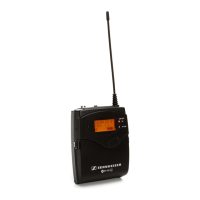
Do you have a question about the Sennheiser sk100-g3 bodypak transmitter and is the answer not in the manual?
| Brand | Sennheiser |
|---|---|
| Model | sk100-g3 bodypak transmitter |
| Category | Transmitter |
| Language | English |
Defines proper usage of the ew 100 G3 series devices, including reading instructions and operating within limits.
Lists key features like PLL synthesizer, HDX noise reduction, Pilot tone squelch, True diversity, and switching bandwidth.
Explains frequency ranges, transmission frequencies, and the structure of frequency banks and channels.
Details compatibility with EM 100 G3 receiver and lists compatible microphones and cables.
Lists microphone types, their pick-up patterns, and instrument cables.
Diagram and numbered list identifying external components of the bodypack transmitter.
Instructions for powering the transmitter using AA batteries or the BA 2015 accupack.
Details on how to charge the rechargeable BA 2015 accupack using the L 2015 charger.
Guide to connecting microphones or instruments to the transmitter's audio input jack.
Explains how to turn the transmitter on and off, including RF mute options.
Describes the function of the ON/OFF, SET, and rocker buttons for menu navigation.
Illustrates the main and extended menus and their items.
Guides on changing settings, selecting menu items, and canceling entries.
Details the options within the main menu, including Sensitivity, Frequency Preset, Name, Auto Lock, and Advanced.
Explains how to adjust audio input sensitivity and provides recommended settings.
How to manually select frequency banks and channels for transmission.
Instructions for assigning a custom name to the bodypack transmitter.
How to enable or disable the auto lock feature to prevent accidental changes.
Details on setting transmission frequencies and selecting channels within the 'U' frequency bank.
Explains how to configure the MUTE switch for audio muting or RF deactivation.
How to use the cable emulation feature to influence guitar sound.
Guide to enabling or disabling the pilot tone for receiver squelch.
How to adjust the contrast of the transmitter's display panel.
Guidelines for pairing transmitter and receiver, including frequency range and legal compliance.
Steps for manual synchronization or using receiver-based automatic sync.
Notes on setting up multiple transmission links without intermodulation interference.
Instructions and precautions for cleaning the device using a damp cloth.
Technical specs for modulation, frequency ranges, bandwidth, and RF output.
Details on compander system, frequency response, signal-to-noise ratio, and THD.
Specs for temperature, power supply, dimensions, and weight.
Technical data for ME 2, ME 3, and ME 4 microphones, including type, sensitivity, and max SPL.
Diagram showing the pinout for the 3.5 mm jack plug for Mic and Line inputs.
Visual representation of microphone pick-up patterns (polar diagrams) for ME 3 and ME 4.
Graph showing the frequency response of the ME 2 microphone across different frequencies.
Graph illustrating the frequency response of the ME 3 microphone at different distances and angles.
Graph showing the frequency response of the ME 4 microphone at different distances and angles.
Industry Canada compliance statements and FCC ID information for Canada.
FCC Part 74 compliance, FCC ID, and limitations for the USA market.
Details the 24-month warranty period for the product and where to find current conditions.
Lists compliance with RoHS, WEEE, and Battery Directives, and disposal information.
States compliance with CE marking, R&TTE, EMC, and Low Voltage Directives.
Explains FCC/Industry Canada compliance rules, interference limits, and user responsibilities.